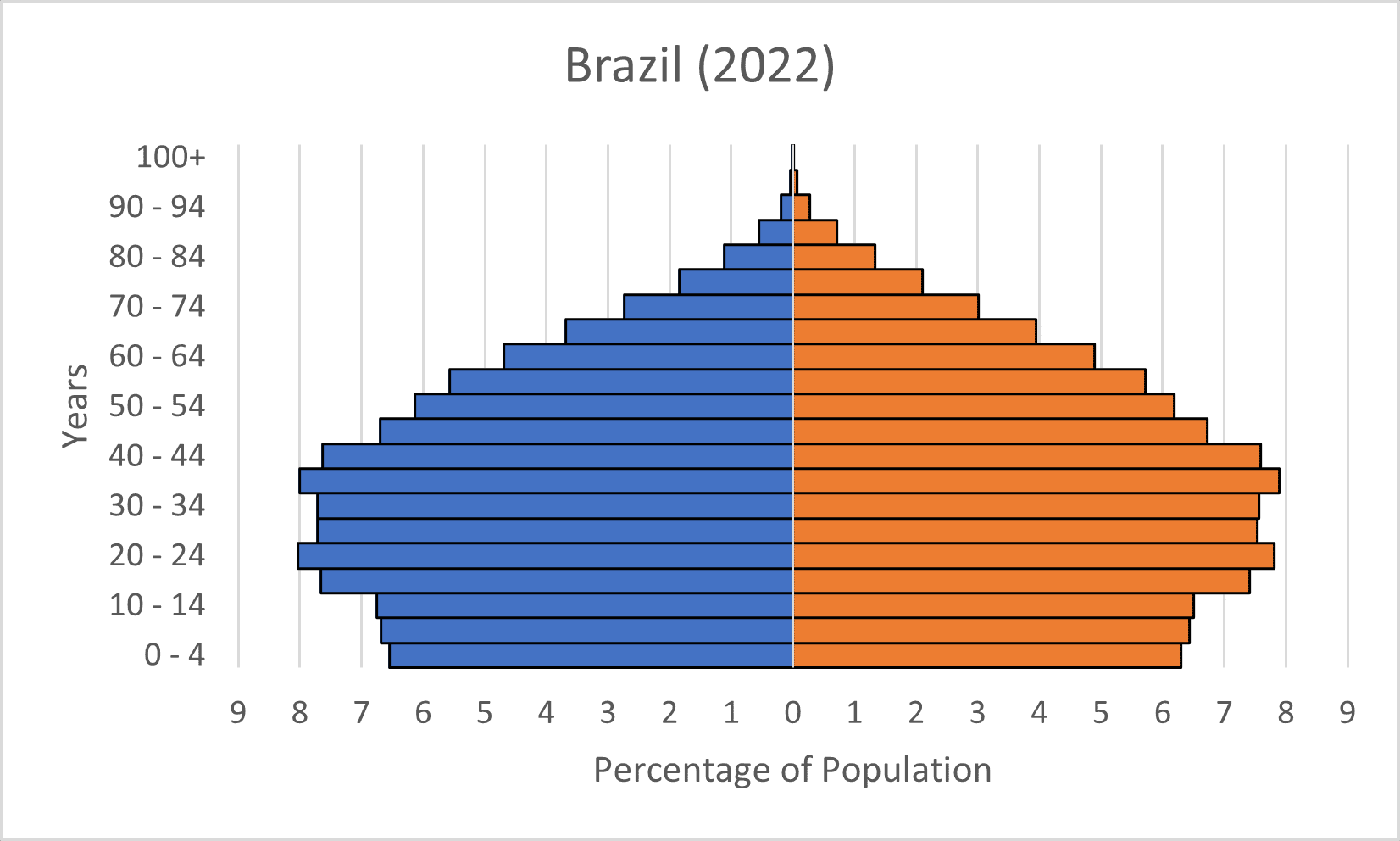Brazil is one of the world’s largest emerging economies and ranks in the top ten most populous countries in the world. It has the longest coastline in South America. Did you know that Brazil has traditionally been a net recipient of immigrants with the southeast being the prime destination? Or, that since the 1960s Brazil has experienced a rapid fertility decline? These and other factors contribute to diverse demographics in South America’s largest country. Take our Brazil population quiz to learn more!
1. In 2015 Brazil’s population was 205 million. What is Brazil’s population projected to be in 2050?
A. 203 million
B. 215 million
C. 229 million
D. 336 million
2. What percent of Brazil’s population resides in urban areas?
A. 14%
B. 26%
C. 87%
D. 95%
3. What does the shape of Brazil’s population pyramid tell us about its growth?
 A. Brazil’s population has been and continues to grow quickly.
A. Brazil’s population has been and continues to grow quickly.
B. Brazil’s population has been growing quickly but it is beginning to slow.
C. Brazil’s population has been decreasing steadily.
D. Brazil’s population is stable.
4. True or False: Brazil is home to two of the 33 current mega-cities (a metropolitan area with a total population in excess of 10 million).
A. True
B. False
5. Brazil has the largest land area in South America with 3.29 million square miles of land. Of those 3.29 million square miles, about ____% of the total land area is protected.
A. 3%
B. 15%
C. 29%
D. 80%
6. What is the most common source of energy in Brazil?
A. Solar energy
B. Oil
C. Nuclear energy
D. Hydropower
7. Today Brazil’s total fertility rate (the average number of children has during her child-bearing years) is ___, down from ___ in 2000?
A. 1.7, 2.3
B. 1.9, 3.3
C. 2.1, 4.4
D. 3.3, 6.3
8. What is the official language of Brazil?
A. Spanish
B. French
C. Portuguese
D. English
9. Brazil is home to __% of the Amazon Rainforest.
A. 15%
B. 30%
C. 45%
D. 60%
10. What percentage of married women in Brazil use some form of contraception?
A. 63%
B. 80%
C. 91%
D. 98%
Answers:
1. C – Brazil’s population is projected to increase to 229 million by 2050.
2. C – 87% of Brazil’s population live in urban areas.
3. B – Brazil’s population has been growing quickly but it is beginning to slow. You can tell because there are a smaller number of people in the younger age cohorts that will go on to bear children.
4. A – True. São Paulo had a population of 21.7 million in 2018 and Rio de Janeiro had a population of 13.3 million making them both megacities.
5. C – Brazil has the largest land area in South America with 3.29 million square miles of land. Of those 3.29 million square miles, about 29% of the total land area is protected, with more than 70% of the protected area in the Amazon biome.
6. B – Oil – 38.4% of Brazil’s energy was derived from oil in 2020, with hydropower providing the second highest amount of energy at 29.4%.
7. A – According to the World Bank, Brazil’s total fertility rate (the average number of children has during her child-bearing years) is 1.7. This is down from 2.3 back in 2000. Brazil has one of the lowest TFR’s in South America.
8. C – The official language of Brazil is Portuguese.
9. D – Brazil is home to 60% of the Amazon Rainforest.
10. B – 80% of married women in Brazil use some form of contraception. Colombia has now surpassed Brazil with the highest percentage in South America, as 81% percent of married women using contraception.
Updated May 2022
References
Question 1:
World Bank Climate Change Knowledge Portal. Summary | Climate Change Knowledge Portal. (n.d.). Retrieved May 10, 2022, from https://climateknowledgeportal.worldbank.org/country/brazil
Question 2:
United Nations Population Division. (n.d.). Urban population (% of total population) – Brazil. World Bank. Retrieved May 10, 2022, from https://data.worldbank.org/indicator/SP.URB.TOTL.IN.ZS?locations=BR
Question 3:
International database. United States Census Bureau. (n.d.). Retrieved May 10, 2022, from https://www.census.gov/data-tools/demo/idb/#/pop?COUNTRY_YEAR=2022&COUNTRY_YR_ANIM=2022&FIPS_SINGLE=BR&FIPS=BR&popPages=BYAGE&POP_YEARS=2022&menu=popViz&ageGroup=5Y
Question 4:
United Nations. (2018). World urbanization prospects – population division. Retrieved May 10, 2022, from https://population.un.org/wup/Publications/
Question 5:
National Geographic Kids. (2021, February 10). Brazil Country Profile. Geography. Retrieved May 10, 2022, from https://kids.nationalgeographic.com/geography/countries/article/brazil
Vieira, R. R. S., Pressey, R. L., & Loyola, R. (2019, March 5). The residual nature of protected areas in Brazil. Retrieved May 10, 2022, from https://www.sciencedirect.com/science/article/pii/S0006320718304531
Question 6:
Ritchie, H., & Roser, M. (2020, November 28). Brazil: Energy country profile. Our World in Data. Retrieved May 10, 2022, from https://ourworldindata.org/energy/country/brazil#what-sources-does-the-country-get-its-energy-from
Question 7:
United Nations Population Division. (n.d.). Fertility rate, total (births per woman) – Brazil. World Bank. Retrieved May 10, 2022, from https://data.worldbank.org/indicator/SP.DYN.TFRT.IN?locations=BR
Question 8:
What languages do people speak in Brazil? (n.d.). Retrieved May 10, 2022, from https://worldpopulationreview.com/countries/brazil/language
Question 9:
Encyclopædia Britannica. (n.d.). Amazon Rainforest. Retrieved May 10, 2022, from https://www.britannica.com/place/Amazon-Rainforest
Question 10:
United Nations Population Division. (n.d.). Contraceptive prevalence, any method (% of married women ages 15-49) – Brazil. World Bank. Retrieved May 10, 2022, from https://data.worldbank.org/indicator/SP.DYN.CONU.ZS?locations=BR
United Nations Population Division. (n.d.). Contraceptive prevalence, any method (% of married women ages 15-49) – Columbia. World Bank. Retrieved May 10, 2022, from https://data.worldbank.org/indicator/SP.DYN.CONU.ZS?locations=CO


